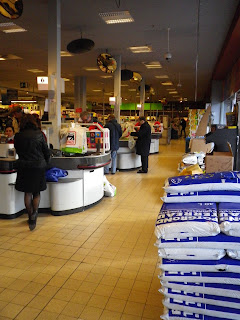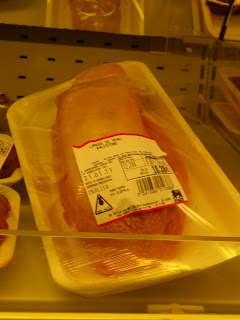When the car pulled out of the driveway in Cortez, I wasn't thinking at all about this date. When I saw the outskirts of Cortez in the rearview mirror of the Toyota, when I got on the plane at Albuquerque International Airport, when I checked into the motel in New York, when I and the group of American exchange students left the ground and watched our nation disappear in the fading light, I wasn't thinking about this date. And when we hit the ground in Brussels, I wasn't thinking about this date either. As I looked ahead at the upcoming year, I had no idea where I would be in six months.
Six months later, I write this after having just returned from a trip to the other side of the country (Arlon), where I danced to techno music with at least 900 people last night. After I finish this post, I will pack for a school trip to Paris this upcoming week, where I will spend four straight days with a group of around 120 of my French-speaking classmates. After that, I go on a trip with 25 six- and seven- year old Balladins (Belgian Scouts) for the weekend. And then I return to school for a week, before leaving for the French Alps to ski with a group of host family friends.
I have lived half a year of my life in this European world. I have experienced things, seen things, discovered things that six months ago, I would never have dreamed of. Here I have found new perspectives, new views, new habits, and new friends. My world has expanded.
I want to write a lot more, to talk about things more specifically and go into more depth than the words I've written here. My experience here is complicated-- it will take more words to give an adequate description of my sentiments at this point in my journey.
So I post today to just mark the date, the date that marks half of a year for me as an AFS exchange student in Belgium. At a later time, when I don't have to prepare myself for a full week of craziness, I will try to describe things a little better.
Until then, I will continue to live my experience.
February 20, 2011
February 10, 2011
Belgian portraits: the supermarket
After school one Wednesday, I headed down Rue Zecrabbe with my camera about 500 meters to Delhaize.
Delhaize is one of the main chains of supermarkets (called supermarchés in French) in Belgium-- you see a Delhaize in almost any town here. The best American comparison for Delhaize, I think, would be a Safeway or an Albertsons. Basically, it's a good example of a normal Belgian supermarket. This one, I admit, is in Uccle, one of the higher-class regions of Brussels, which means it's a little bit...prettier...than some. But that's generally the case anywhere you go. So at any rate, I think that you can learn a lot about a country by seeing what's sold at its supermarkets. So here goes....
Entering the parking lot (located on the roof of the store), you can easily tell you're in Europe by looking at the cars. No Dodge pickup trucks here....actually, the silver car you see near the center of the photo could be considered "big" by European standards.
Anyway, the first glance at a Belgian grocery store looks like any grocery store in the United States.
You see the cash registers, the flourescent lights, etc... things don't look much different.
Same with the produce section-- it looks almost identical to something you'd see in the States...except for "Belgium's finest" pears.
However, there are some vegetables that are distinctively Belgian.
Belgian Endive, for example, called chicon in French. It's a bitter, whitish-green vegetable that's eaten a lot here-- my host mom loves it. It tastes a bit like a cross between cabbage and dandelion greens. At first, when I tried it, I wasn't much of a fan, but I'm starting to develop a taste. It's very Belgian.
Also eaten here quite a bit are leeks, called poireaux in French. They're very mild, and tasty in soup.
A group of popular Belgian vegetables. On the far right you can see choux de Bruxelles. Any guesses on what that translates to?
Moving into the bakery, it begins to look different than the United States.
There's at least ten different kinds of sweet pastries each day, plus dozens of different kinds of bread. They're baked each morning, so they're almost never stale.
Same with the bread. You pull out the loaf, put it into a slicing machine, and then slip it into a paper sack. You never have to buy soft, preservative-filled bread in plastic bags. And no matter what kind of bread you buy here, it has an actual crust. Crazy, huh?
Moving into the cookie/packaged foods aisle, you see something very Belgian...
Waffles! In plastic sacks! Who would've thought...? People here eat them a lot, actually, just as a snack. In my opinion, they taste a little like stale angelfood cake. Not bad, but not as good as fresh waffles.
Speculoos! Mention these to any Belgian, and he or she will smile.
It's always weird to see American brands. In fact, there's a lot of them here-- chips, cookies, sugary cereals....more or less good American junk food.
However, in the chocolate section, there are no American brands. You can't find Hershey's...in fact, nobody here knows what Hershey's chocolate is.
There's tons of chocolate here. The chocolate section takes up half an aisle-- a good 50 feet of boxes and boxes of amazing chocolate.
Aah, Belgium...
However, you can't forget the gommies. For all the good chocolate, the Belgians love gummy candy as well.
Another place where you can see the difference in culture is in the alcohol aisle. Well... the alcohol aisles plural. In Colorado, where I'm from, the laws make it so no alcohol apart from 3.2 beer can be sold at supermarkets. That makes a huge change between Colorado and Belgium.
Here, there are three different (full-sized) wine aisles, with wines and champagnes from all over France, Italy, Spain, Portugal, (maybe a few from Belgium), plus North America (I think), South America and Australia.
And that's only the wine. There's another seperate aisle for the liquor...
Yeah. You could say that people are a little more easy-going here when it comes to alcohol.
Ok, so, as someone from the southwestern United States, I had gotten somewhat used to a good-sized selection of Mexican-style food (pinto beans, green chiles, tortillas, etc...) available in the grocery store. In Belgium, because the geographical distance to Mexico is about ten times greater than that from Colorado, it's not like that at all. The "Mexican" food is crammed in along with the Asian noodles, the British boiled beans, and nori for sushi. There are not even any canned green chiles. And the selection you see in the picture below (pretty much everything in the red wrappers-- the section is no more than 5 feet across) is the most diverse I've ever seen ehre-- look at how many different kinds of salsa there are (3!). It's funny to see a cuisine I'm so used to seem so exotic.

Ok, so, as someone from the southwestern United States, I had gotten somewhat used to a good-sized selection of Mexican-style food (pinto beans, green chiles, tortillas, etc...) available in the grocery store. In Belgium, because the geographical distance to Mexico is about ten times greater than that from Colorado, it's not like that at all. The "Mexican" food is crammed in along with the Asian noodles, the British boiled beans, and nori for sushi. There are not even any canned green chiles. And the selection you see in the picture below (pretty much everything in the red wrappers-- the section is no more than 5 feet across) is the most diverse I've ever seen ehre-- look at how many different kinds of salsa there are (3!). It's funny to see a cuisine I'm so used to seem so exotic.

Heading into the meat section, you see more or less the same things you'd see in an American supermarket--chicken, steaks, pork, etc... but there are some other things I've never seen in Cortez City Market:
Beef tounge...
Beef bones (people boil them in soup and eat the marrow...)
And beef heart.
While the American food system is more oriented to grinding up these different parts of the animal and turning them into hot dogs, the Europeans generally integrate things like beef heart and tounge into fine cuisine.
Moving away from the meats into the breakfast aisle, you see lots of American cereals...
But also other very Belgian things: chocolate spreads, for example:
Chocolate spread, on freshly-bought bread, is a great breakfast.
And, of course, you can't forget the Nutella. Probably one of the most consumed products here in Belgium. While Nutella in the U.S. is generally sold in little tubs that are the height of your ring finger, here in Europe the normal size is 750 grams-- more than 1.5 pounds. A normal family can finish one jar within less than 5 days. And somehow, Belgians aren't fat at all.
A lot of times, the differences between the American and Belgian grocery stores are really subtle-- the types of things that you don't notice unless you really pay attention.
For example, the milk. You don''t find it in the refrigerated section here; you find it in bottles at room temperature. You refrigerate it at home. It tastes exactly the same-- it's just not in gallon jugs. After four months or so living here, I realized that-- "oh yeah, there's no such thing as gallon milk jugs..."
The freezer section looks pretty the same as one you'd find in the U.S.... ice cream, frozen pizzas, frozen vegetables, etc...but you can also find ten or so different brands of pre-cut potatoes to make fries, and "croquettes," which are like tater tots made with mashed potatoes (they're delicious). Also, you can't find very many "ready-made" foods like frozen dinners. They exist, but they're considered kind of a "novelty" item, and you hardly ever hear of people who eat them on a daily basis.
When you look up at the signs for the aisles, they're written in two languages-- Dutch and French. That's the same with all the product lables (unless they're not in English), all the ads in the windows, and the reciepts you get after you pay.
Finally, going into the aisle listed on the sign above, you see the beers.
Bam. They stack these crates over 8 feet high, and each has 24 bottles of beer.
Aand, below is the thing that, in my opinion, says "Belgium" the most. Look closely at the picture.
On the left side is the water-- probably 15-20 different brands. And on the right side is....the beer. Probably at least 50 different kinds, stretching for 50-60 feet.
That's how you can tell you're in a Belgian supermarket--when the beer and the water are sold the same aisle.
Subscribe to:
Posts (Atom)




































